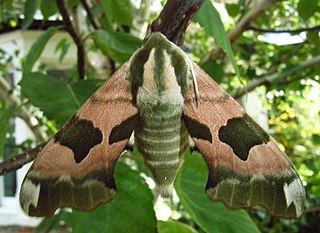
Mimas tiliae, the lime hawk-moth, is a moth of the family Sphingidae. It is found throughout the Palearctic region and the Near East, and in northern Spain (Europe). The species was first described by Carl Linnaeus in his 1758 10th edition of Systema Naturae.
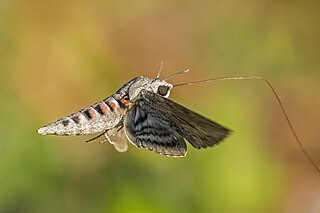
Agrius convolvuli, the convolvulus hawk-moth, is a large hawk-moth. It is common throughout Europe, Asia, Africa, Australia and New Zealand, partly as a migrant. In New Zealand, it is also known as the kumara moth, and in the Māori language as hīhue.

Psilogramma menephron, the privet hawk moth or large brown hawkmoth, is a member of the family Sphingidae. It was described by Pieter Cramer in 1780. It is usually found in Sri Lanka, India, Nepal, central and southern China, Thailand, Vietnam, Indonesia and the Philippines. Psilogramma casuarinae from eastern Australia was long treated as a synonym but is now thought to be a distinct species. The introduced population on Hawaii was first thought to be P. menephron, but is Psilogramma increta.

Callionima nomius, the fan-tailed bark moth, is a moth of the family Sphingidae. The species was first described by Francis Walker in 1856.

Smerinthus ocellatus, the eyed hawk-moth, is a European moth of the family Sphingidae. The species was first described by Carl Linnaeus in his 1758 10th edition of Systema Naturae.

Proserpinus clarkiae, or Clark's sphinx, is a moth of the family Sphingidae. The species was first described by Jean Baptiste Boisduval in 1852. It is known from British Columbia and Washington south through California to Baja California, east to Idaho, Wyoming and Utah. The habitat consists of oak woodland and pine-oak woodland in foothills.

Deilephila porcellus, the small elephant hawk-moth, is a moth of the family Sphingidae. The species was first described by Carl Linnaeus in his 1758 10th edition of Systema Naturae.

Macroglossum fritzei is a moth of the family Sphingidae. It is known from south-eastern China, central and southern Japan, Thailand and Borneo.

Macroglossum mitchellii, the grey-striped hummingbird hawkmoth, is a moth of the family Sphingidae described by Jean Baptiste Boisduval in 1875. It is known from Sri Lanka, southern and eastern India, Thailand, southern China, Taiwan, Vietnam, Malaysia and Indonesia.

Sphinx canadensis, the Canadian sphinx, is a member of the family Sphingidae. The species was first described by Jean Baptiste Boisduval in 1875.

Leucophlebia lineata, the large candy-striped hawkmoth, is a moth of the family Sphingidae. It was described by John O. Westwood in 1847. It is known from Sri Lanka, India, Nepal, Thailand, eastern and southern China, Taiwan, Cambodia, Vietnam, Malaysia, Indonesia and the Philippines. It is a minor pest of sugarcane.

Coelonia fulvinotata is a moth of the family Sphingidae first described by Arthur Gardiner Butler in 1875. It is known from most habitats throughout the Afrotropical realm, from the Gambia east to Ethiopia and south to northern South Africa and Madagascar.
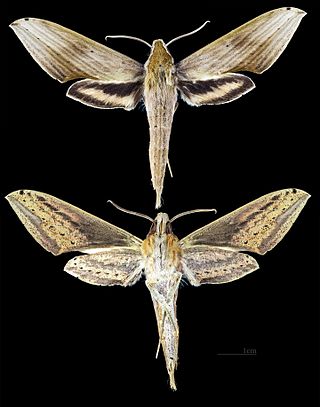
Xylophanes libya, the Libya sphinx, is a moth of the family Sphingidae. The species was first described by Herbert Druce in 1878. It is known from southern Texas, Mexico, Belize, Guatemala, Panama and from Venezuela south and west to Bolivia and Paraguay.
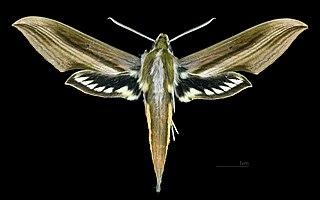
Xylophanes schreiteri is a moth of the family Sphingidae. It is known from Argentina and Bolivia.

Xylophanes thyelia is a moth of the family Sphingidae. The species was first described by Carl Linnaeus in his 1758 10th edition of Systema Naturae.
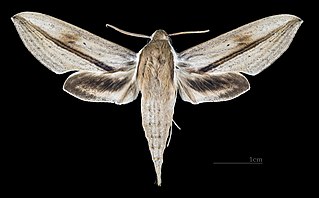
Xylophanes turbata is a moth of the family Sphingidae. It is known from Mexico to Nicaragua and Costa Rica. An occasional stray may be found up to southern Arizona.
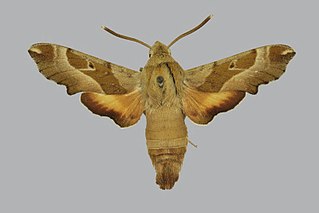
Proserpinus gaurae, the proud sphinx moth, is a moth of the family Sphingidae. The species was first described by James Edward Smith in 1797. It is found from Texas and Louisiana east to northern Florida, north to Alabama, Missouri, northern Georgia and South Carolina. It may range as far south as northern Mexico.

Eupanacra metallica is a moth of the family Sphingidae first described by Arthur Gardiner Butler in 1875.

Cechenena lineosa, the striped green hawkmoth, is a moth of the family Sphingidae. It is known from northern India, Nepal, Bangladesh, Myanmar, Thailand, southern China, Taiwan, Vietnam, Malaysia and Indonesia.

Pachygonidia caliginosa is a moth of the family Sphingidae first described by Jean Baptiste Boisduval in 1870.





















